- Thread starter
- #41
Navigation
Install the app
How to install the app on iOS
How To Use Progressive Web App aka PWA On 420 Magazine Forum
Note: This feature may not be available in some browsers.
More options
You are using an out of date browser. It may not display this or other websites correctly.
You should upgrade or use an alternative browser.
You should upgrade or use an alternative browser.
Brix Aware 1.0
- Thread starter R2MNot
- Start date
shizznizzle
New Member
Ok I admit it...patients is not one of my best virtues.
All but 2 seeds were above ground this morning.
I have 20 days to go before the soil is ready, with the current growth rate the veg room will be over run in that amount of time
Looking sweet R2, not such a bad dilemma to have! Being overrun and all.....really looking happy and healthy.


The Natures own tea arrived yesterday. Started brewing a batch last night. I will hit everything with it tonight.
Going to try to pick up some Yucca today as well.
I highly recommend using the nature's own at 1/4 to 1/2 strength. It's very, very strong and will eat up everything in your soil if you're not careful.
Brew it exactly as instructed, with 1/4 cup NO per gallon of water, but dilute it 20 to 1 before watering with it. Even at this dilution rate it's stronger than anything else out there.
I have to agree with Doc, that stuff is super strong. I was wondering why this round of ladies looked so much different, it was because I was diluting it 10:1 and it ate everything in my soil up. Last round was at least 20:1 and they came out nice and shiny, with it 10:1 they just look like a hydro plant. I had to add 6-5-3 and some food and pray for the best 

I have to agree with Doc, that stuff is super strong. I was wondering why this round of ladies looked so much different, it was because I was diluting it 10:1 and it ate everything in my soil up. Last round was at least 20:1 and they came out nice and shiny, with it 10:1 they just look like a hydro plant. I had to add 6-5-3 and some food and pray for the best
Don't add any more tea for a while. They'll come back pretty quick once the current batch of microbes age and die off.
This is a learning process....and indeed we are learning! The good news is that Nature's own tea will last a long, long, long time.....=less money!
AmenDon't add any more tea for a while. They'll come back pretty quick once the current batch of microbes age and die off.
This is a learning process....and indeed we are learning! The good news is that Nature's own tea will last a long, long, long time.....=less money!
 Yeah they just getting bubbled h20 for a while
Yeah they just getting bubbled h20 for a while 
- Thread starter
- #47
Got it 20:1 on the tea.
I think i am going to dump this batch, something is not right. I have been using ac/dehumidifier run off...i notice last night when i put the air stone in the water ( before adding the tea) I was getting a lot of bubbles, so i stuck my head down in the bucket to get a good whiff...it smelled kinda soapy or something, not foul just off. When the tea went in it really foamed up right away and the smell of the tea was strong...but just now i checked on it and now i can smell that soapy smell over the tea.
So I think i will dump it on the veg garden and try again with RO tonight.
Hey, question on RO and amended soil...do we need to worry about adding cal/mag to RO water?
Lately I have been folair feeding cal/mag with good results but it would be great to just ditch it.
I think i am going to dump this batch, something is not right. I have been using ac/dehumidifier run off...i notice last night when i put the air stone in the water ( before adding the tea) I was getting a lot of bubbles, so i stuck my head down in the bucket to get a good whiff...it smelled kinda soapy or something, not foul just off. When the tea went in it really foamed up right away and the smell of the tea was strong...but just now i checked on it and now i can smell that soapy smell over the tea.
So I think i will dump it on the veg garden and try again with RO tonight.
Hey, question on RO and amended soil...do we need to worry about adding cal/mag to RO water?
Lately I have been folair feeding cal/mag with good results but it would be great to just ditch it.
I bubble hot tap water for 2 day's before I brew my tea. In the sanitation classes I've had to take they tell us that "water over 125 degrees f kills the active ingredient in chlorine". I don't have space here to install a RO system(damn condo's), I do the same thing with my rdwc set up too, works just fine.
Got it 20:1 on the tea.
I think i am going to dump this batch, something is not right. I have been using ac/dehumidifier run off...i notice last night when i put the air stone in the water ( before adding the tea) I was getting a lot of bubbles, so i stuck my head down in the bucket to get a good whiff...it smelled kinda soapy or something, not foul just off. When the tea went in it really foamed up right away and the smell of the tea was strong...but just now i checked on it and now i can smell that soapy smell over the tea.
So I think i will dump it on the veg garden and try again with RO tonight.
Hey, question on RO and amended soil...do we need to worry about adding cal/mag to RO water?
Lately I have been folair feeding cal/mag with good results but it would be great to just ditch it.
Once you get your soil up and running, you can water with whatever you want. Straight RO is just fine between feedings.
I'm lazy right now...could you remind me what your soil is and what you're feeding? I'll try to make sure you're headed in the right direction.
- Thread starter
- #50
The container was the problem with the tea...watch out for cheap trash cans.
Started over in new container...looks and smells like it should.
5gal PromixBX
2gal perlite
1gal humus
2.5 pounds worm cast
1/2 cup 6-5-3 CaC03,Soft Rock Phosphate(granulated),Gypsum(granulated)
1/4 cup Azomite
1/2 cup Chick Magic
Chick Magic
5% nitrogen
3% phosphate
2% soluble potash
0% sulfur
Natures Own
Bloomit,amaxe,PGR
RO/ac run off
Tap cut in 1/2 with RO hits 60-70 Total alkalinity
on hand:
Plenty of OC+
cal/mag
2K 6X3
co2 1500
day 85
night 75
50rh
5gal homer buckets
Started over in new container...looks and smells like it should.
Once you get your soil up and running, you can water with whatever you want. Straight RO is just fine between feedings.
I'm lazy right now...could you remind me what your soil is and what you're feeding? I'll try to make sure you're headed in the right direction.
5gal PromixBX
2gal perlite
1gal humus
2.5 pounds worm cast
1/2 cup 6-5-3 CaC03,Soft Rock Phosphate(granulated),Gypsum(granulated)
1/4 cup Azomite
1/2 cup Chick Magic
Chick Magic
5% nitrogen
3% phosphate
2% soluble potash
0% sulfur
Natures Own
Bloomit,amaxe,PGR
RO/ac run off
Tap cut in 1/2 with RO hits 60-70 Total alkalinity
on hand:
Plenty of OC+
cal/mag
2K 6X3
co2 1500
day 85
night 75
50rh
5gal homer buckets
The container was the problem with the tea...watch out for cheap trash cans.
Started over in new container...looks and smells like it should.
5gal PromixBX
2gal perlite
1gal humus
2.5 pounds worm cast
1/2 cup 6-5-3 CaC03,Soft Rock Phosphate(granulated),Gypsum(granulated)
1/4 cup Azomite
1/2 cup Chick Magic
Chick Magic
5% nitrogen
3% phosphate
2% soluble potash
0% sulfur
Natures Own
Bloomit,amaxe,PGR
RO/ac run off
Tap cut in 1/2 with RO hits 60-70 Total alkalinity
on hand:
Plenty of OC+
cal/mag
2K 6X3
co2 1500
day 85
night 75
50rh
5gal homer buckets
You're set up pretty much perfectly! Keep an eye out, they may need more chicken manure soon. Also, you might feed once or twice with some fish hydrosylate (cold processed fish.) I think you're looking at a really nice grow.

- Thread starter
- #52
Wow after reading this I don't see how anyone would want to feed salt to their plants.
Lifted from this page: The Story of Soil | Energy Bulletin
And this statement:
Makes me think that breeding is the only reason we see "hydro" out yielding "soil" grows.
If "brix" grows catch on there could b a whole new nitch for seed banks to fill.
I dont see me going back to hydro, yea brix is a pain in the butt, yea it has cost me a little more, no there is not much documentation on it, hell google "High brix" and DocBud will be on the first results page.
Lifted from this page: The Story of Soil | Energy Bulletin
What is the difference between soil and dirt?
Soil is alive. Dirt is dead.
A single teaspoon of soil can contain billions of microscopic bacteria, fungi, protozoa and nematodes.
A handful of the same soil will contain numerous earthworms, arthropods, and other visible crawling creatures.
Healthy soil is a complex community of life and actually supports the most biodiverse ecosystem on the planet.
Modern soil science is demonstrating that these billions of living organisms are continuously at work, creating soil structure,
producing nutrients and building defence systems against disease. In fact, it has been shown that the health of the soil community is key to the health of our plants, our food and our bodies.
Why is it then, that much of the food from the conventional agricultural system is grown in dirt? The plants grown in this lifeless soil are dependent on fertilizer and biocide inputs, chemicals which further destroy water quality, soil health and nutritional content.
How did we get here? How do we turn this around? This is the Story of Soil...
Turning and Ploughing Soil
It all started about 10,000 years ago when humans started ploughing the fields in the experiment called agriculture. The settlers noticed that when they ploughed the field their crops would grow faster. Based on this positive feedback it was concluded that ploughing must be constructive and more fields were turned. However, in actual fact the bacteria, fungi and arthropods in the soil are essentially nutrient locked up in biology. For example, bacteria is almost 90% nitrogen. Ploughing the soil was killing the life in the soil resulting in an unregulated jolt of nutrient available to the surrounding plants. Over time, with the death of all soil microbes, the soil is unable to naturally support life and the farmer had to move to more fertile ground. The agricultural pattern emerged: deforest, plough, irrigate, salinate, desertify, move on.
How the Synthesis of Acid Changed the World
About one hundred and fifty years ago humans discovered how to synthesize sulphuric acid. The synthesis of acid allowed for a major advance in industrial agriculture: the ability to dissolve rock minerals into a water-soluble form. This meant that macro-nutrients such as nitrogen (N), potassium (P) and phosphorus (K) could be added to the soil in a form that could be taken up by plants.
As acid was discovered at around the same time as petroleum, this meant the advent of harder, faster and larger-scale ploughing with the use of water soluble salt-based minerals. Again, what could be wrong with a system that produces so much?
Plants and Their Roots
Plants have two main types of roots: tap roots and hair roots. Tap roots are responsible for hydrating the plant, i.e. drinking water. Soil does not freely feed or give minerals (such as calcium, magnesium, etc) to plants and so in order to get minerals a plant must make a "trade" with the soil biota — this is the primary function of the hair roots. Therefore the hair roots are the mineral traders and create an environment around themselves called the rhizosphere - a habitat for soil biota.
Through the process of photosynthesis plants produce exudates (sugars) and commit up to fifty percent of these sugars to the action of feeding and trading with the biology in the soil. When the plant needs a certain mineral, say calcium, it offers exudates to the biota that can provide calcium. This is a symbiotic process in which the plants support the biota and the biota support the plant.
And so, if you plough soil and kill off the biota and soil microorganisms, how does a plant get minerals? The industrial solution is to feed the minerals to the tap roots, i.e. put water-soluble dissolved minerals in the drinking water, otherwise known as fertilizer. The advent of nitrogen, potassium and phosphorus fertilizer (NPK) meant that we did not need to rely on a bank of soil biology to make our plants grow. We could add macro-nutrients at whatever rate we desired and grow plants faster and quicker than ever before — in increasingly lifeless soil.
Have you ever salted a slug? What happens? The salt creates a large osmotic pressure on the creature's cell wall and results in death. This analogy can be used to understand what happens to the soil biology when salt-based fertilizer is used (note that all fertilizer is based in mineral salts). So the salting of the land through broad-acre fertilization ensures that the biology is completely dead. As long as we keep applying fertilizer there is no chance for life to return.
Without life in the soil, no natural mineral exchange can occur. Also, with plants being forced to drink mineral soup through the tap root, less energy is devoted to developing an overall healthy root structure. Fertilizer has become an addictive drug. It has eliminated the soil biota, replaced that function in the ecosystem, and now must be continually applied. Whoever controls the fertilizer market secured their market share the same way as the cocaine dealer.
The Downward Spiral
By the late fifties farmers were using NPK at record levels, tractors were highly advanced and the soils in the world were on a fast track to doom. The use of mono-culture crops, heavy tilling, irrigation and fertilizer was killing the soil and making our plants weak and addicted to chemicals. Monocrops of these obese and sick plants became an all-you-can-eat buffet for pests and the degraded and depleted soils a great opportunity for pioneer species (i.e. weeds).
"No worries!" proclaimed the Chemical Companies, "we've got the solution for that too". Let's kill these pests and nasty weeds that are causing all the problems — and thus pesticides and herbicides were born.
Without healthy soils to support beneficial fungal population the next problem to emerge for farmers was fungal issues. The "next solution" - apply fungicide!
We are now left with dead, acidic and salted soils that are only good for holding up plants.
Weeds and What they Tell
Carbon is the building block of life. Any soil scientist, gardener or farmer will tell you that a soil with no carbon is a dead soil. Carbon and nitrogen like to bond together at a rate of 30:1 and most gardeners know that mixing too much carbon into (like mulch or straw) will decrease available nitrogen. The reverse is true as well and adding nitrogen (in the form of fertilizer) actually reduces carbon levels in the soil. Without carbon, fungus has no food source and dies. The soil collapses leading to hard packed dirt and anaerobic conditions (no oxygen). What comes next are Nature's signs of a sick system trying to heal itself: weeds, pests and erosion.
It has been proven that the weeds that grow on the surface of the soil are a response to a condition in the soil. For example, pig weed and thistle grow in soils high in nitrates (i.e. fields that have had a history of fertilizer use), and bracken ferns and blady grass grow in soils deficient in potassium (i.e. soils that have burned). Therefore, most of the agricultural weeds that we spray with herbicides actually have an ecological function. Club root, dandelion, knapweed, chickweed and amaranth all indicate too much nitrogen and anaerobic conditions - they are trying to build the topsoil carbon levels.
Weeds such as these do not divert a lot of the photosynthesis energy into soil biology relationships and instead they produce thousands of seeds and lots of carbon - they are fast carbon pathways. As the carbon in the soil increases, the soil is able to support fungal associates and bacterial populations encouraging the next stage of succession and return to soil health. Fast growing weeds and pest attacks are mechanisms in nature to eliminate monospeciation and increase biodiversity. If we truly wanted to stop the weeds and pests, the only real solution is to first understand why they are there. Weeds give us clues as to how to repair the soil and how to prescribe techniques to speed up the repair process. For example, if thistles are trying to build soil so that biodiverse life can return to it, we can speed up the soil-building process by adding the right plants and life back into the soil.
Patterns Repeat Themselves
Instead of seeing the pattern that got us here in the first place we tend to trust in the system that misunderstood from the beginning. The countermeasures in industrial agricultural have all been based on too narrow a definition of what is wrong. When a decision is made to cope with the symptoms of the problem, second generation problems are created. It has now come to the point where we've invented and hybridized plants to grow in degraded soil / dirt and genetically modified our food to be tolerant of pesticides, herbicides and fertilizer. However, the use of chemicals is not just stopping the natural succession of the ecosystem, it is turning the clock backward toward death or desert.
I find it particularly interesting that the soil & chemical Ag industry is the same pattern as the human & pharmaceutical industry. Treat the symptoms. Patent the "cures". Profit from the lack of health. I also suspect that the slow death of the healthy soil ecology over the last hundred years of intensive agriculture could be directly correlated to the increase in disease, illness and mineral deficiency in the human species.
There is an old saying from a farmer that I am particularly fond of: "I am sick of growing things that die and killing things that want to live". It is amazing to me how much energy and money we spend in our quest to kill when all nature wants to do is live. Imagine what the world would look like if we invested the billions of dollars that currently go into killing weeds, pests, and fungi on processes that encourage life, and work with rather than against nature. The more you look at the current system the more you realize that our quest for domination over the soil is perpetuating a system of scarcity. What we need more than ever is a new paradigm to support a system of abundance and life.
Lucky for us that new paradigm exists! It is a branch of soil science that is called the Soil Foodweb. Paul Taylor of "Trust Nature" has been an organic farmer for over 30 years and is one of many to show that the use of aerobic compost and compost tea can turn dead degraded dirt into life-giving soil in as little as three years. The cycle of biocides is being replaced with a cycle of life. When we design properties to harvest water which fix the water cycle and apply biology through compost the results are nothing short of miraculous. Nature wants to come back, we just have to help her out a bit. Best of all, permaculture gives us all of the design tools to make this a reality
And this statement:
It has now come to the point where we've invented and hybridized plants to grow in degraded soil / dirt and genetically modified our food to be tolerant of pesticides, herbicides and fertilizer
Makes me think that breeding is the only reason we see "hydro" out yielding "soil" grows.
If "brix" grows catch on there could b a whole new nitch for seed banks to fill.
I dont see me going back to hydro, yea brix is a pain in the butt, yea it has cost me a little more, no there is not much documentation on it, hell google "High brix" and DocBud will be on the first results page.
Just the taste makes the few extra dollars you spend worth while, not to mention how "clean" the effect is or how long it lasts.
Wow after reading this I don't see how anyone would want to feed salt to their plants.
Lifted from this page: The Story of Soil | Energy Bulletin
And this statement:
Makes me think that breeding is the only reason we see "hydro" out yielding "soil" grows.
If "brix" grows catch on there could b a whole new nitch for seed banks to fill.
I dont see me going back to hydro, yea brix is a pain in the butt, yea it has cost me a little more, no there is not much documentation on it, hell google "High brix" and DocBud will be on the first results page.
Growing nature's way is the best way. That's all High Brix is....maximizing the fertility of the soil for super healthy Biota (great new term!) and boosting that with proper foliar feeding.
It works for other crops, from grasses to Almond trees, with melons, blueberries, tangerines and tomatos....it'll work for our favorite crop too. And it is....oh my, is it ever.
Just the taste makes the few extra dollars you spend worth while, not to mention how "clean" the effect is or how long it lasts.
You won't be spending much on it in the near future bro. After I make a good run or two with the new stuff, I'm going to make it available to people. By the end of next week I'll have a refractometer, extraction press, 3 new foliar sprays, two brand new nutrient drenches, a new root inoculant and a new microbial product, all straight from the lab and the soil recommendation. It should be epic. Stay tuned.
RE: taste and effect. I'm glad you see it that way too. The taste is so pleasant, healthy tasting and the effect is definitely "bigger," or something like that.
My cooked soil is very much like yours. It will definitly play a part in my second grow of the season when my temps are cooler.
ajagunle
New Member
Brilliantly informative journal!
‘I also suspect that the slow death of the healthy soil ecology over the last hundred years of intensive agriculture could be directly correlated to the increase in disease, illness and mineral deficiency in the human species.’
Big business in control is having a detrimental effect on so many aspects of our lives, and so our long-term security, a possible Avatar back story?
You are so right about Doc Buds’ Google listings, trying to search for High Brix for soft fruit and all Google knew was MMJ and Doc!
‘I also suspect that the slow death of the healthy soil ecology over the last hundred years of intensive agriculture could be directly correlated to the increase in disease, illness and mineral deficiency in the human species.’
Big business in control is having a detrimental effect on so many aspects of our lives, and so our long-term security, a possible Avatar back story?
You are so right about Doc Buds’ Google listings, trying to search for High Brix for soft fruit and all Google knew was MMJ and Doc!
- Thread starter
- #57
Cheese in Brix soil got some natures own a few days ago and then lastnight a second shot of amaze/pgr
Getting some yellowing on the lowers, they also look over watered to me, going to let them dry out good before they get anything else.
Watering might be a little bit of a learning curve for me coming off hempy
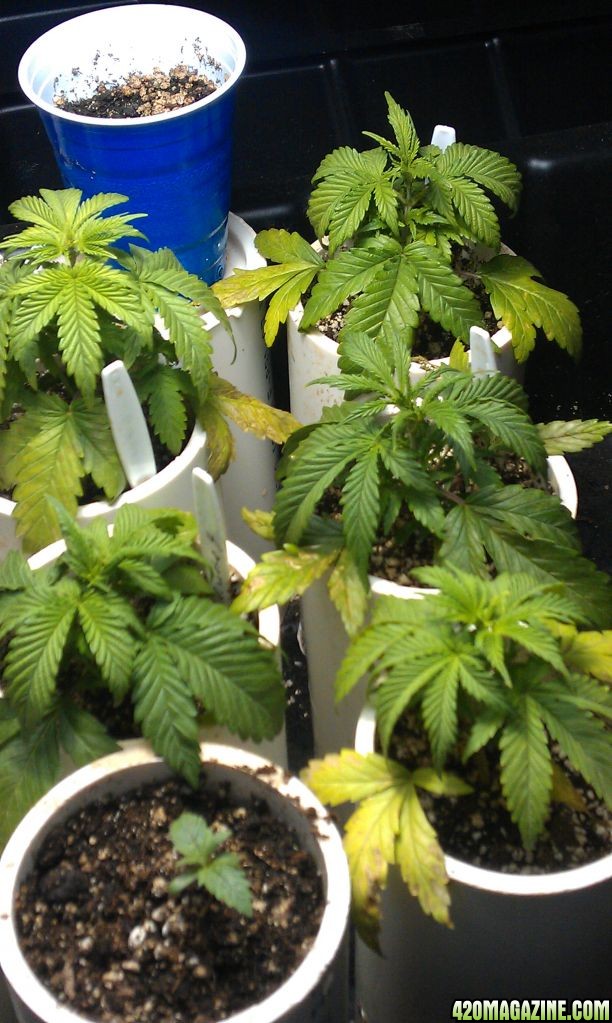

Harvested a bunch of hempy...that opened up a spot for the brix sprouts under a 1k bulb
These should b off to the races in a day or 2
inbred ak47 in 2qt brix soil

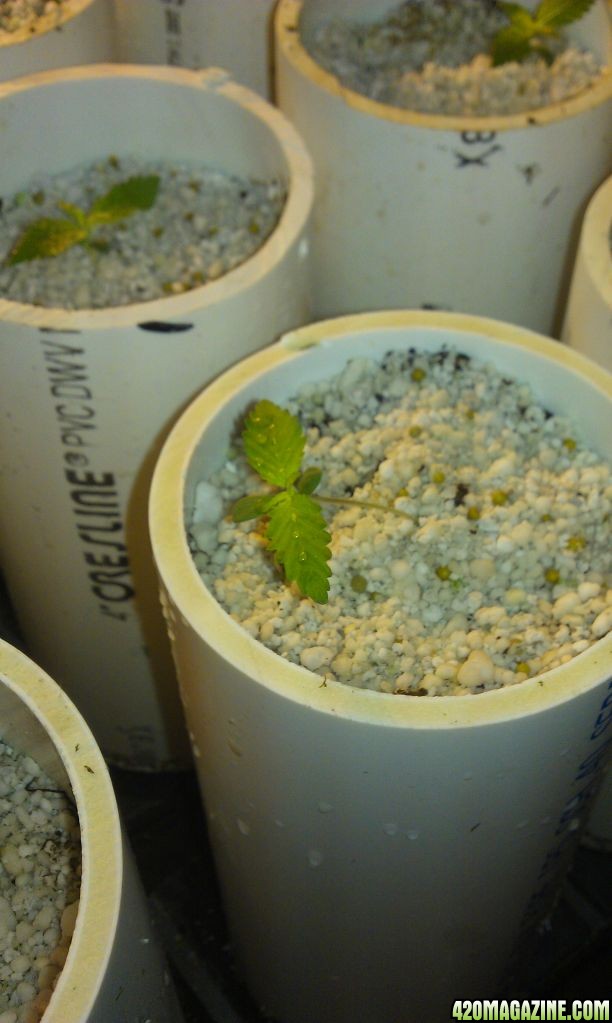
Ak47 Hempy hot off the grill


Some of the hempys look a little grumpy...no more playing with tea and foliars on the hempy.
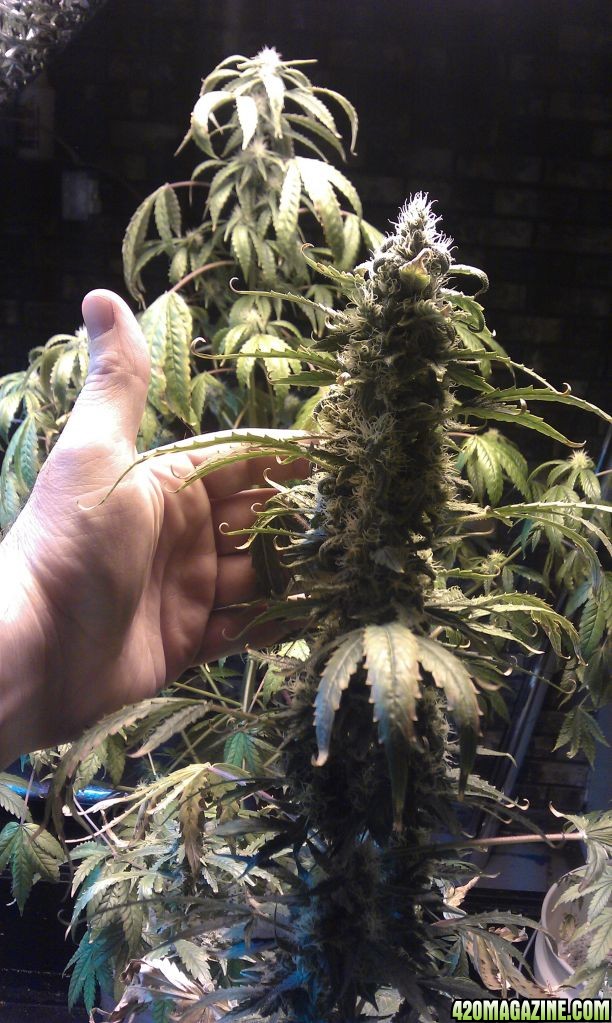
Getting some yellowing on the lowers, they also look over watered to me, going to let them dry out good before they get anything else.
Watering might be a little bit of a learning curve for me coming off hempy


Harvested a bunch of hempy...that opened up a spot for the brix sprouts under a 1k bulb
These should b off to the races in a day or 2
inbred ak47 in 2qt brix soil


Ak47 Hempy hot off the grill


Some of the hempys look a little grumpy...no more playing with tea and foliars on the hempy.

Very nice  . The watering, I stick my finger in about 2 knuckles in and see how it feel's, hope that helps.
. The watering, I stick my finger in about 2 knuckles in and see how it feel's, hope that helps.
 . The watering, I stick my finger in about 2 knuckles in and see how it feel's, hope that helps.
. The watering, I stick my finger in about 2 knuckles in and see how it feel's, hope that helps.subd mate, if you dont mind me tagging along for the ride
- Thread starter
- #60
Sprouts are doing well. The ones on the outside went in today. After a 5 hour soak some were already cracking.
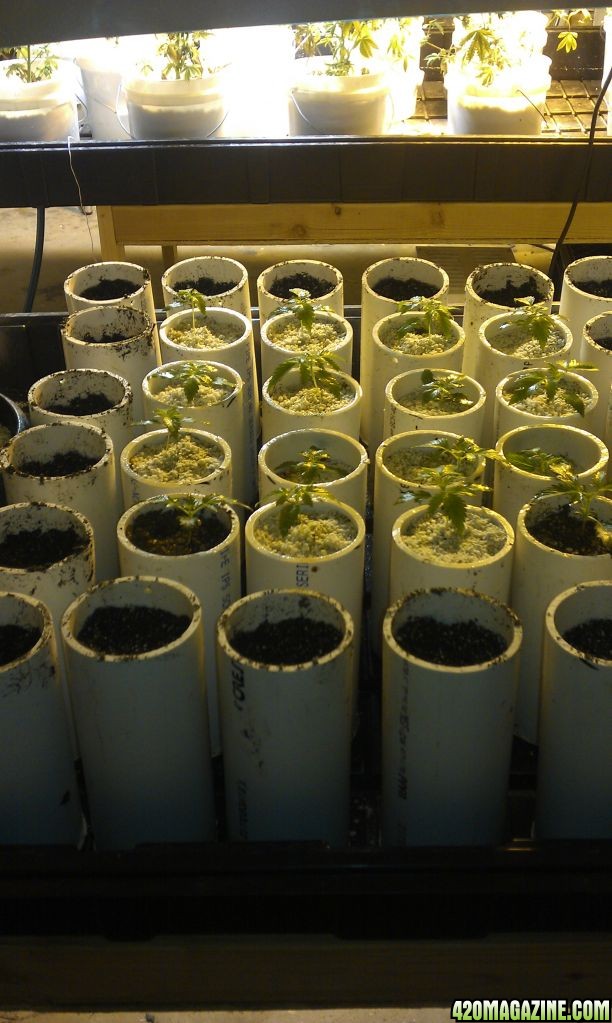
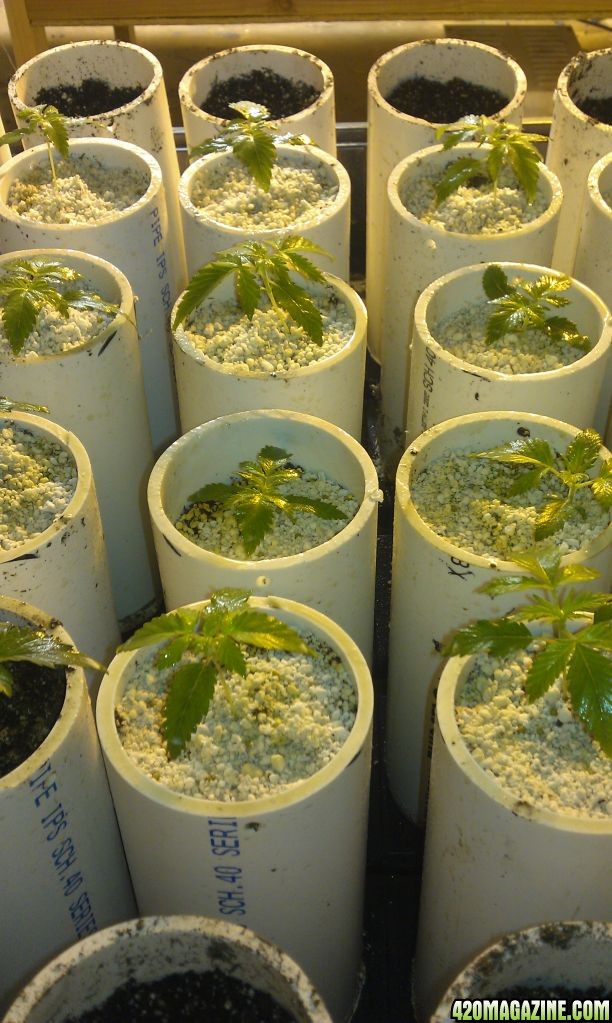
Hempy is still chugging along...they should finish up soon
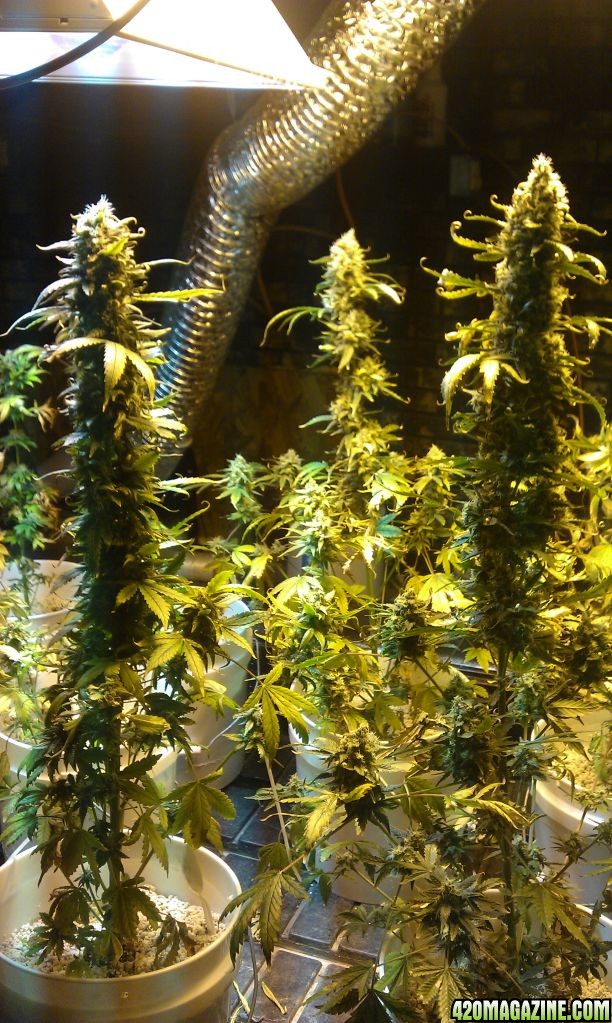


Hempy is still chugging along...they should finish up soon



